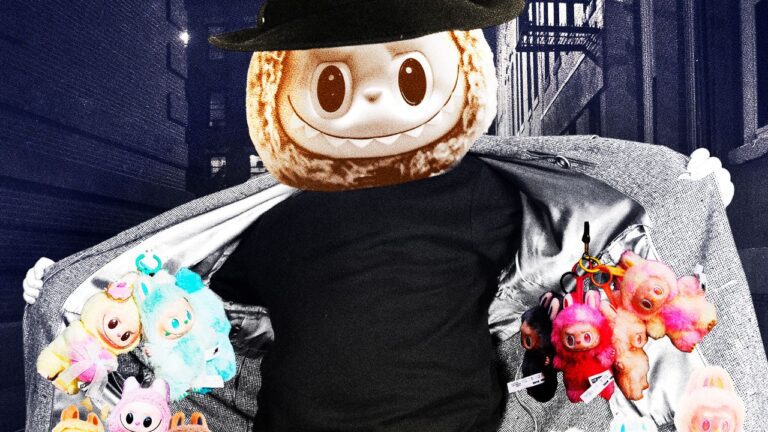Based on a character created in 2015 by the Hong Kong artist Kasing Lung and inspired by elvish forest monsters of Nordic folklore, each Labubu—no bigger than an iPhone—features soft fur, spiky claws, a pronounced brow ridge, and a grinning row of jagged teeth. (All Labubus are canonically female, though they have a reclusive male leader, Zimomo, who has a dragonlike tail.) In recent months, I’d seen them on TikTok and Instagram, being birthed from mylar pouches in the unboxing videos that had infiltrated my algorithm. I’d seen them on the train and in the office, dangling from the purses of both bracefaced teenagers and chic grown women who work in fashion. As is my default mode, I had largely felt unmoved—even repulsed—by the phenomenon. And then one day on the subway, when I spotted a Labubu clipped onto an elegant stranger’s The Row Margaux bag—the doll was wearing a mini sweater set that looked like it could have been from Isabel Marant’s spring 2012 collection—I began to reconsider my stance. Maybe these dolls are fine, I thought. Even sweet. Look at people being creative!
The day before I went to the mall, I’d first seen Labubus for sale in person when I walked by a display of them in the window of a vintage shop on the Lower East Side. Curious, my friend Sydney and I walked in and asked the cashier how much each box cost. When she told us the price—$60 a pop—we both laughed out loud in shock. That’s how much a Labubu costs?
When two teenage boys inside the store warned us of paying anything less than $60 for a real Labubu, I knew I was a rookie here. I didn’t yet know the depths of the marketplace for collectible misfit toys—or how quickly I would fall down its rabbit hole.
Gilbert Carrasquillo
Which is how, during a casual day trip to Flushing with our friends Serena and Eliza, Sydney and I wound up seeking out the source: Pop Mart. At the mall, the plexiglass cases at Pop Mart displayed a retail price (a cool $27.99 per Labubu) but there were no physical boxes to be found. A small sign directed us to scan a QR code to purchase the dolls online for in-store pickup. Naively, we scanned the code, which led to an error message. They were totally sold out.
Oh, well, I thought to myself, as we walked around the store and browsed the other blind-box offerings. Surely I can find some other silly thing to waste $20 on right now.
My friend Sydney, newly determined by this quagmire, swung back around to the plexiglas Labubu case. She glanced at them longingly. Then, she heard a man’s voice nearby.
“Are you trying to get one of those?” the man said, his voice low. “I have some.”
“How much?” Sydney asked. “Between $45 and $60,” he replied, vaguely. She demurred, declining his offer.
But it was at that moment, Sydney told me later, that something shifted. “I felt excited about the idea of having one,” she recalled. “It felt like the first time that one could be mine.”



